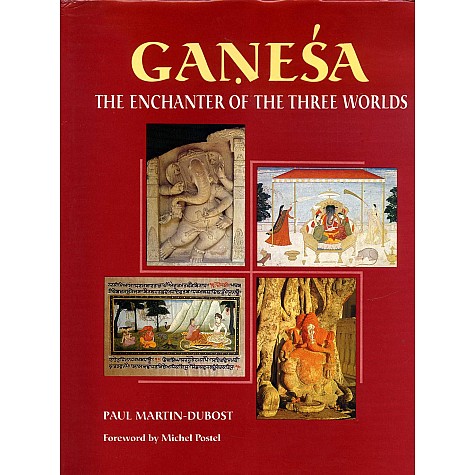Ganesha: The Enchanter of the Three Worlds-Paul Martin-Dubost-9788190018432
- Brand:Franco Indian
- Product Code: KAVYADP15
- Availability: 2-3 Days
-
Rs.2,800.00
- Ex Tax: Rs.2,800.00
Ganesha: The Enchanter of the Three Worlds-Paul Martin-Dubost
| Since
several millennia, the god with the elephant’s head, Ganesa, the very Soul of
Speech, god of good luck who creates or removes at his pleasure the obstacles
to the realization of a project, is venerated in India and in a large part of
Asia at the commencement of every ceremony, every enterprise, every spiritual
quest. In the vast Hindu pantheon, Ganesa is Ganapati, the First among the gods, the Chief of the rumbling army of the ganas, the servitors of Siva. He is engaged in protecting them, he marches and triumphs with them. Ganesa is equally associated with the Mothers, the Matrkas, sometimes represented as seven or sometimes as eight; and with the nine planets (Navagrahas) whose leader he is. Closely associated with yoga, Ganesa guards in each of us the first cakra, muladhara, situated at the base of the vertebral column, where he embraces the vital force. The elephant-faced god has penetrated all the strata of the religious life of India, and in this book, Ganesa, the Enchanter of the Three Worlds, are described the different stories of the birth of the son of Parvati and Siva; his combats with the demons of jealousy, of intoxication, of illusion, of greed, of anger, of desire, of ego and of immeasurable pride; his marriage with Buddhi and Siddhi, the daughters of Brahma; the components of the daily family cult and those of the great annual festival in August-September, in the course of which flowers, perfumes, lights, sweets and twenty-one medicinal leaves are offered to him. The oldest figures doubtless were made, like today for certain rites, with perishable materials which have not survived. The earliest iconographic forms are terracottas fashioned by hand or made in simple moulds. Around the beginning of the Christian era followed in the distant region of the immense peninsula, in the caves and rock-cut sanctuaries, the earliest representations of Ganesa in bas-relief or in the round. Easily recognizable because of his elephant head, he is seated or standing. He has yet no forest of arms. He alternates in his hands some principal emblems: the solitary tusk, the axe, a radish, a lotus flower, rice corn, the elephant goad, the noose, and the bowl of sweets. At the time when his forms came to be diversified under the artistic impulse of the Guptas, in the IVth century, his cult and his iconography progressively spread and extended over the whole of Asia. Towards the VIIth century, the female energy of the god, the Sakti, was personified in the monumental statuary of India, then in bronzes. Apparently at the same time and parallel to the numerous domestic cults, the sculptors came to represent Ganesa occupied in dancing in the niches of the great temples, in the north as also in the south of India. Poets, authors, dramatists, panegyrists rivaled in inventing with the great creators of forms, and at the close of the IXth century, the arms of the god progressively increased from two to twenty. In this work, Paul Martin-Dubost presents a complete book of the subtle iconography of Ganesa in India. Each of the forms (there exist thirty-two principal forms) is specified by the alteration of the attributes in the hands, the colour and the particular vehicle. Flowers, vegetables, fruits, weapons, musical instruments, sweets, besides gestures of the fingers (mudras) reveal an instruction. Nuanced like music, rich in artistic meaning. Present in all the eyes, Ganesa is the Initiator of Beauty! The book illustrated with 450 colour and black-and-white photographs, of which a large number are published for the first time, permits the readers to discover the extraordinary variety of the forms of Ganesa, from the self-manifested, svayambhu, to those representations modelled in metal or fashioned in materials as diverse as pink sandstone, basalt, diorite, granite, white marble, black porphyry, steatite, green schist and phyllite; those modelled in metal alloy or in gold or ivory; or again those very delicate ones revealed by the brush of the miniaturist. A Sanskrit Glossary of more than 2,500 words and a detailed Bibliography enumerates since the XVIIIth century, the principal stages in the investigation and the iconographic reflection. This study will guide the reader to the four corners of India, and to its history, for close to two thousand years. |
| Book | |
| ISBN | 9788190018432 |
| PUBLISHER | FRANCO INDIAN |
| Pages | 412 |
| Binding | 0 |
| Edition | 1997 |
| Language | ENGLISH |
Tags: Ganesha: The Enchanter of the Three Worlds-Paul Martin-Dubost

